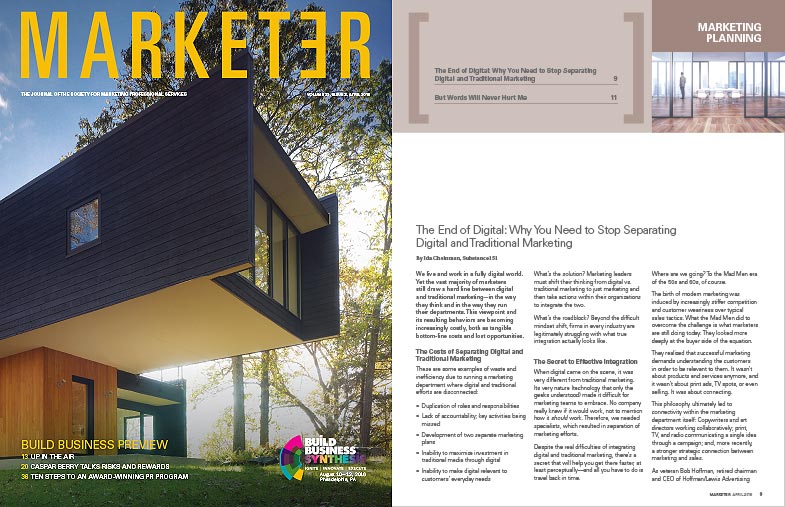
This article was first published in the SMPS Marketer – bimonthly journal by the Society for Marketing Professional Services (SMPS).
We live and work in a fully digital world. Yet the vast majority of marketers still draw a hard line between digital and traditional marketing – in the way they think and in the way they run their departments. This viewpoint and its resulting behaviors are becoming increasingly costly, both as tangible bottom-line costs and lost opportunities.
These are some examples of waste and inefficiency due to running a marketing department where digital and traditional efforts are disconnected:
What’s the solution? Marketing leaders must shift their thinking from “digital vs. traditional marketing” to just “marketing” and then take actions within their organizations to integrate the two.
What’s the roadblock? Beyond the difficult mindset shift, firms in every industry are legitimately struggling with what true integration actually looks like.
When digital came on the scene, it was very different from traditional marketing. Its very nature (technology that only the “geeks” understood) made it difficult for marketing teams to embrace. No company really knew if it would work, not to mention how it should work. Therefore, we needed “specialists.” Separation was the result.
Despite the real difficulties of integrating digital and traditional marketing, there’s a secret that will help you get there faster, at least perceptually – and all you have to do is travel back in time.
Where are we going? To the Mad Men era of the 50s and 60s, of course.
The birth of modern marketing was induced by increasingly stiffer competition and customer weariness over typical sales tactics. What the Mad Men did to overcome the challenge is what marketers are still doing today: they looked more deeply at the buyer side of the equation.
They realized that successful marketing demands understanding the customers, in order to be relevant to them. It wasn’t about products and services anymore, and it wasn’t about print ads, TV spots, or even selling. It was about connecting.
This philosophy ultimately led to connectivity within the marketing department itself: copywriters and art directors working collaboratively; print, TV, and radio communicating a single idea through a “campaign”; and, more recently, a stronger strategic connection between marketing and sales.
As veteran Bob Hoffman, retired chairman and CEO of Hoffman/Lewis Advertising, wrote, “Marketers overestimate the attraction of new things and underestimate the power of traditional consumer behavior.” In fact, “digital” is just another tool for conducting types of marketing like publicity or sales.
Visioning true integration of traditional and digital marketing does demand serious thought and planning, but, given the history, why are we making it so hard?
The perceptual hurdle is only part of the picture. It’s important because it will remind you that “marketing” is not about the tools but rather about the relationship with your customers – customers who are already living in a fully integrated world.
Your job, then, is to make sure that your marketing department’s operations and work product mirror that fully integrated world by integrating all marketing activities across all channels.
To realize that commitment, follow these steps:
Once your marketing department is thinking about connection with the customer above all else, you’ll have created the bridge between traditional and digital. Soon after, the bridge itself will disappear, and all you and your team will be doing is “marketing.”
Today’s Digital Reality: An Essential Guide for Professional Services Marketing
Leading the Charge Through Digital Transformation
Innovating Professional Services Marketing to What’s Next